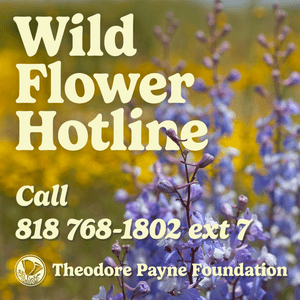Wild Flower Hotline April 18, 2025
Driving around Lake Kaweah in the southern Sierra foothills east of Visalia, the landscape is transitioning from early to mid-spring bloom. Eastwood’s fiddlenecks are fading, and the hillsides are shifting from deep gold to brilliant yellow as the madia comes into flower. Surprisingly early this year, the harbingers of summer—speckled clarkia are already starting to make bold splashes of pink on the sunnier slopes. Amidst the pinks and yellow, are occasional patches of orange foothill poppies and pale blue fiesta flowers. Here and there, purple pagodas in their royal purple cloaks, add to this colorful oak woodland landscape. Annual lupines of two varieties, spider lupine and miniature lupine decorate the roadsides and slopes in varying shades of blue. Around the lake, the silver bush lupine floral show is fading as their developing seed pods are growing fat and plump. Taking their place on rocky and shadier north-facing slopes are the bold yellow bush monkey flowers. Drive slowly to see that amongst the monkey flower, clinging to tiny rock crevices, are hundreds of canyon dudleya. Glowing with their bright orange candelabra-like blooms, they stand out dramatically against their chalky-white foliage. Most of the rock faces preferred by these two plants along with mats of rock lichens, display a burnished deep orange-red color making for quite an impressive presentation. There are also local geophytes in full bloom, including pink twining brodiaea [broh-dee-ah], buttery yellow pretty face and purple Ithuriel’s spear. While there are not a great number, this is one of the best places to find the elegant, and arguably the “queen” of Calochortus—pink fairy lanterns. Also coming into mid-spring bloom on sunny slopes and trails are diminutive blooming Heermann's golden sunburst, bird’s-eye gilia, tom cat clover and mustang clover. A few weeks ago, we reported on the devastation left by last summer’s Lake Fire on Figueroa Mountain in the Los Padres National Forest. Notably, poppies and lupines were emerging from the blackened landscape. While many mature trees and shrubs perished, the wildflower display currently is beyond belief! Look for regional fire-following annuals, including fiesta flowers, chia, goldfields, globe gilias, blue dicks, Mariposa lilies, miner’s lettuce, red skinned onions, various phacelias, silver puffs, chocolate lilies, yellow monkeyflowers, sky lupines, wallflowers California golden violets and many more. Some perennials are making their way back as well. Look for silver bush lupine, California buckwheat and bush poppy. Make the effort to visit before the weather gets hot. The iconic colors of California—the rich golds and blues—are unfurling through the gardens at the Theodore Payne Foundation. Joining the California poppies, fiddlenecks, sunflowers, and California sun cups are, this week, the Palo Verde trees now in glorious bloom. This palette of yellow gold is now coupled with desert bluebells, chia, several sage species and the electric blue showy penstemon. Cheery yellow blossoms of bush sunflower, canyon sunflower and Nevin’s barberry are brightening up pathways elsewhere. Trekking up Wildflower Hill adjacent to the sales yard, you will encounter fragrant Cedros Island verbena, woolly blue curls, and California four o’clock. Enjoy this explosion of color and by the way, many of these can also be purchased at the TPF plant sale this weekend!

